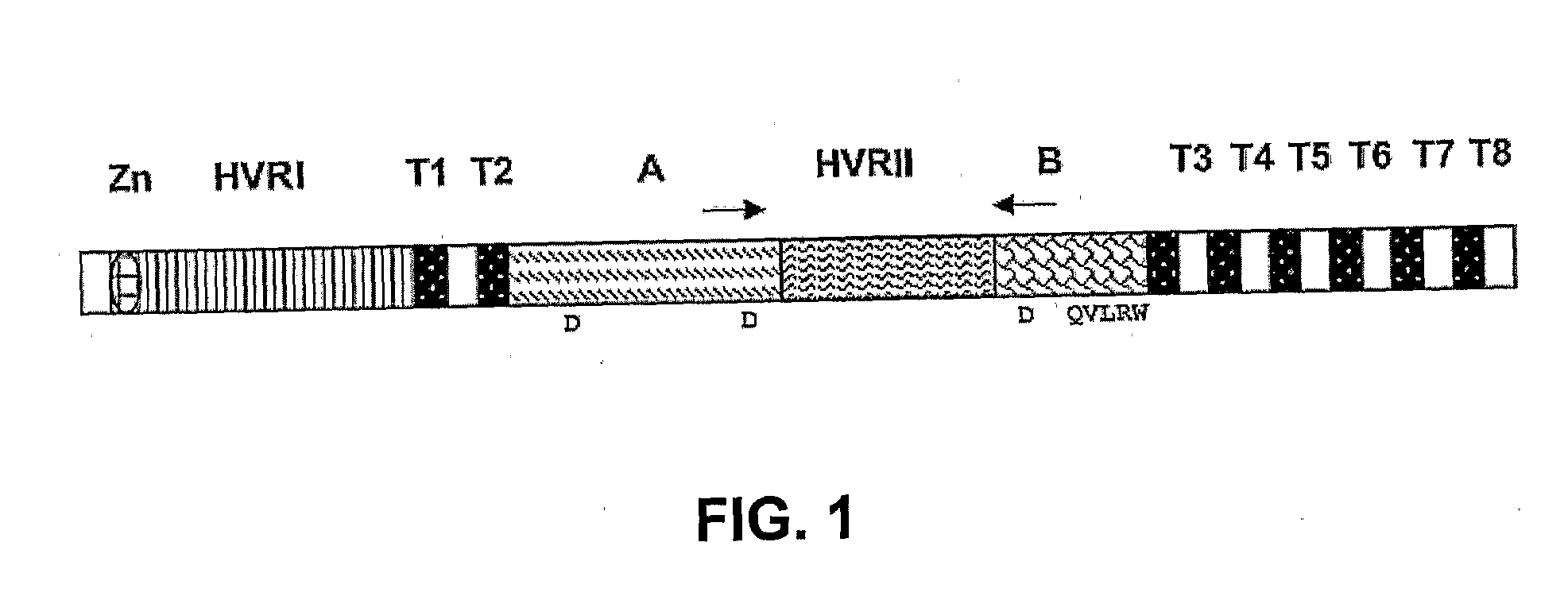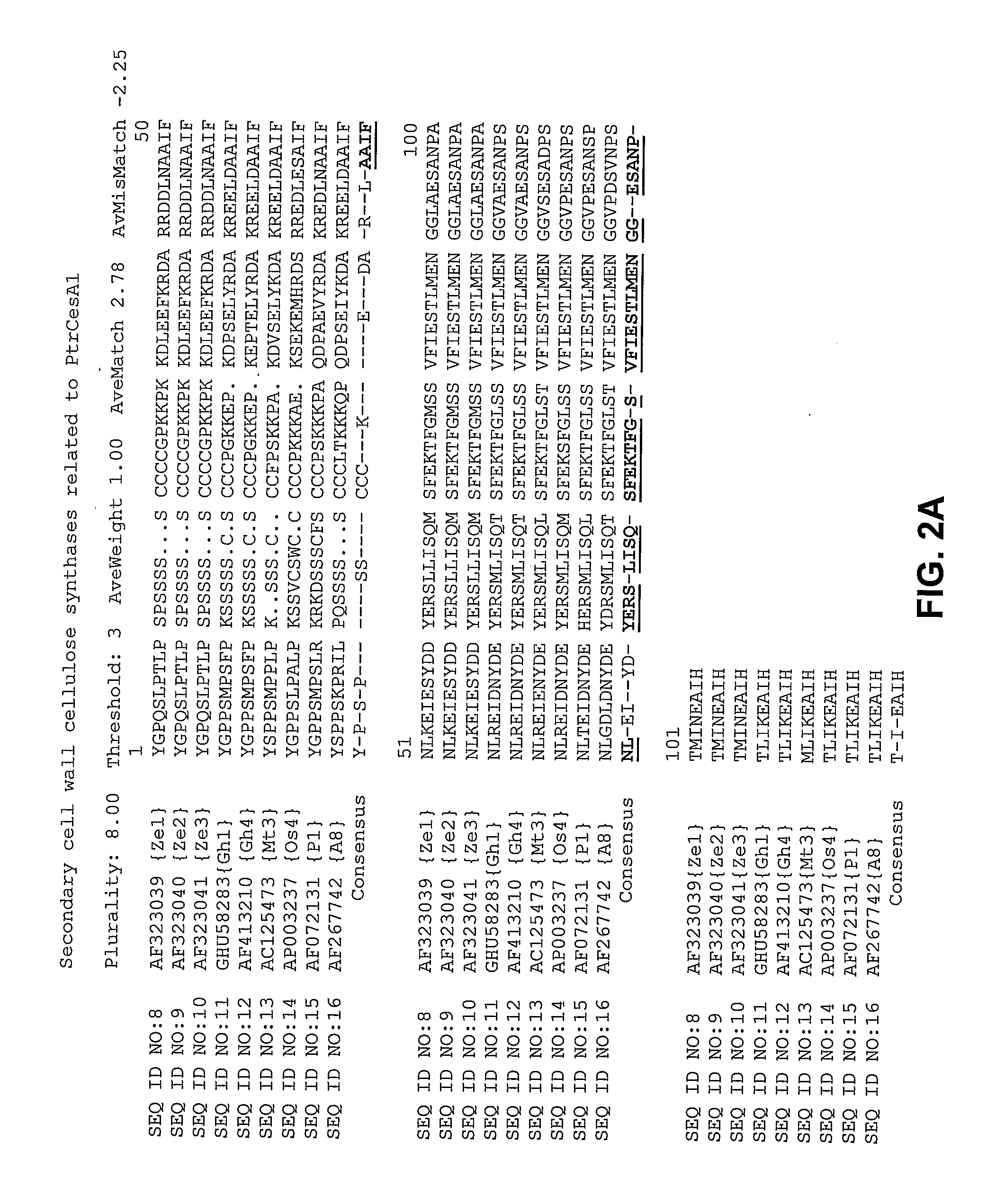Methods for Enhancing Expression of Secondary Cell Wall Cellulose Synthases in Plants
a cell wall cellulose and synthase technology, applied in the field of methods for enhancing the expression of secondary cell wall cellulose synthases in plants, can solve the problem that little is known about the cellular factors controlling these traits, and achieve the effect of enhancing growth
- Summary
- Abstract
- Description
- Claims
- Application Information
AI Technical Summary
Benefits of technology
Problems solved by technology
Method used
Image
Examples
example 1
[0031]The materials and methods described below are used in Examples 2 and 3.
A. Preparation of Constructs
[0032]Three binary vector constructs comprising PtrCesA1, PtrCesA2 or PtrCesA3 were prepared as follows. The pBI121 backbone was used to make these constructs, with the GUS gene replaced by a specific PtrCesA in the sense direction. In each of the three cases, a specific PtrCesA cDNA was amplified using a primer pair that incorporates the necessary unique restriction sites for cloning the specific PtrCesA in pBI121 vector, as shown in FIG. 4.
[0033]For the PtrCesA1 overexpression construct, pBI121 was digested by XbaI and Ecl136II (an isoschizomer of SacI which produces a blunt end) (Fermentas, N.Y.), resulting in an open vector with 5′ end sticky and 3′ end blunt. PtrCesA1 cDNA was amplified from an existing plasmid in pBluescript vector using a pair of primers with XbaI site at the 5′ end and KpnI site at the 3′ end in the presence of pfu enzyme. This amplified product was then ...
example 2
Aspen and Tobacco Plants Transformed with One, Two or Three Secondary Cell Wall Cellulose Synthases Under the Control of the 35S Promoter
A. Tobacco
[0040]Tobacco plants expressing the PtrCesA1, PtrCesA2, and PtrCesA3 polynucleotides under the control of the 35S cauliflower mosaic virus constitutive promoter grew faster and were taller than mature tobacco plants expressing zero, one or two of the introduced PtrCesA1, PtrCesA2, or PtrCesA3 polynucleotides (see FIG. 5).
B. Aspen
[0041]Aspen plants expressing all three introduced secondary cell wall cellulose synthase polynucleotides (PtrCesA1, PtrCesA2, and PtrCesA3) each under the control of the 35S cauliflower mosaic virus constitutive promoter will grow more vigorously and faster than those comprising zero, one or two of the introduced PtrCesA1, PtrCesA2, or PtrCesA3 polynucleotides. During regeneration of the plants, explants will grow faster than plants comprising only the vector, or those expressing two of the secondary cell wall ce...
example 3
Tobacco Plants Comprising 1, 2 or 3 Secondary Cell Wall Cellulose Synthases Under the Control of the PtrCesA1 Promoter
[0042]The mean heights of transgenic tobacco plants expressing zero, one, two or all three of the introduced PtrCesA1, PtrCesA2, or PtrCesA3 polynucleotides are presented in Table 2. Table 2 also shows the mean girth of plants 45 days after transfer to the greenhouse. The number of plants of each type is indicated in parenthesis. A1, A2 and A3 are used in Table 2 as an abbreviation for plants overexpressing vectors carrying PtrCesA1, 2 and 3 respectively. Control pBI121 in Table 2 represents a plant transformed with the pBI121 vector only. Measurements presented in Table 2 were taken when the plants were approximately 3-months old, at 15 days, 30 days and 45 days after being transferred to the greenhouse.
TABLE 2Height and girth of tobacco plants 15, 30 or 45 days after transfer to thegreenhouseHeight (cm)Girth (mm)15 days30 days45 days45 days Control pBI1212630509.3(...
PUM
| Property | Measurement | Unit |
|---|---|---|
| humidity | aaaaa | aaaaa |
| temperature | aaaaa | aaaaa |
| structure | aaaaa | aaaaa |
Abstract
Description
Claims
Application Information
 Login to View More
Login to View More - R&D
- Intellectual Property
- Life Sciences
- Materials
- Tech Scout
- Unparalleled Data Quality
- Higher Quality Content
- 60% Fewer Hallucinations
Browse by: Latest US Patents, China's latest patents, Technical Efficacy Thesaurus, Application Domain, Technology Topic, Popular Technical Reports.
© 2025 PatSnap. All rights reserved.Legal|Privacy policy|Modern Slavery Act Transparency Statement|Sitemap|About US| Contact US: help@patsnap.com



